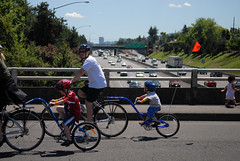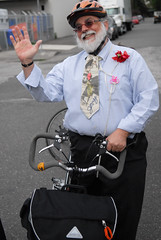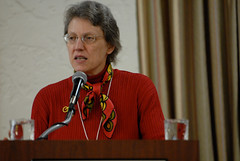As I reported on Tuesday, a major organizational shift is taking shape at the Oregon Department of Transportation (ODOT). For the first time ever, ODOT will have an official Active Transportation “section” within the agency.
ODOT Director Matt Garrett made the announcement yesterday via an internal email, saying it was one of the agency’s “first steps to pursue a more multimodal vision.”
Not unexpectedly, reactions to the news were mixed. Those close to ODOT (staff, advisory committee members, and so on) are excited about the announcement, while those on the outside looking in (advocates, citizen activists, city staff), are skeptical.
“The citizens of Oregon have been asking for a more diverse portfolio of ways to get around the state as fuel prices rise and as people don’t have the money in their household to have one car per person.”
— Lynn Peterson, transportation policy adviser to Governor Kitzhaber
In a nutshell, ODOT says the move is intended to make it easier for communities to implement bicycling and walking projects. They plan to bring together non-highway staff and programs (like Safe Routes to Schools, the 1% set-aside from the Bicycle Bill, state bike/ped grants, Transportation Enhancements, and so on) under one roof in hopes of a more collaborative, strategic and holistic approach to project planning and implementation.
The problem currently is that each one of those programs are scattered throughout ODOT, tied to different funding sources (some state, some federal) and cycles, and overseen by a dizzying array of divisions and managers. The result is confusion, wasted time (wading through the bureaucracy), and projects (if they get done at all) that serve the process instead of the desired outcome.
ODOT hopes the changes will solve those problems.
In addition to a physical change of location, the org chart shuffling puts the Active Transportation Section in position to someday become a full-fledged “Division” within ODOT — carrying the same internal weight as the vaunted Highway Division.
A.J. Zelada, the Chair of the Oregon Bicycle and Pedestrian Advisory Committee (OBPAC) calls the move a “breath of fresh air” and a “terrific celebration of the 40th anniversary of the Oregon Bike BIll.” Zelada, (speaking for himself, not the OBPAC) says having a single section for all active transportation programs within ODOT is like “breaking a glass ceiling.”
According to ODOT, the move is a natural evolution, spurred by years of grumbling by ODOT staff, stakeholders, and even by Gail Achterman — Chair of the Oregon Transportation Commission (OTC), the governor-appointed advisory committee that sets policy for ODOT.
You’ll recall that Achterman hinted at her frustrations at the 2010 Oregon Bike Summit. During a keynote speech at that event, Achterman said an analysis of the Byzantine nature of biking and walking funding and programs was “thought-provoking.” “It shows we’ve got dribs and drabs of money across a whole bunch of program areas,” she said.
In an interview yesterday, Achterman said she’s “very excited” about the changes being made.
“It brings all the people working in all these different programs together as one team, all reporting to the same person so that we can have them all applying their expertise to the community problems all at the same time. That kind of team development never happened because it’s hard when you’re in different buildings with different people to report to.”
Asked for an example of how the new section might impact bicycle project implementation, Achterman brought up the Oregon Bicycle Bill (a minimum 1% of highway project money must be spent on bicycling and walking improvements) and the bike lanes on Highway 97 in Bend.
“Does it really make the most sense to spend it on the highway project [which is the common practice at ODOT currently], or to spend it on some other bike project that the community has already prioritized?”
Think of the new Active Transportation Section like a clearinghouse within ODOT, where a team of experts work in collaboration to make sure every non-highway dollar spent in Oregon gets maximum bang for the buck. On that team will be people like Sheila Lyons, who has toiled valiantly as the manager of ODOT’s Bicycle and Pedestrian Program.
For years, Lyons has been buried way down the org chart, making it hard for her to muster the staff resources or internal respect given to her highway counterparts. With the re-structuring, Lyons will go from 7-8 people down the org chart (see below), to only having to report to one manager before getting to Director Matt Garrett. “It’s a move up, it’s better recognition,” an ODOT staffer told me.
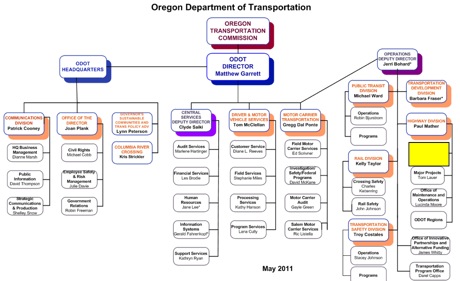
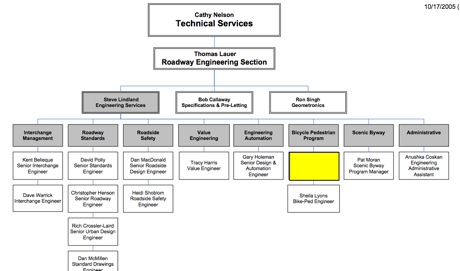
Beyond just internal pressure to change the way active transportation business is done in our state, Lynn Peterson thinks some credit for this structural shift at ODOT belongs to Oregonians. Peterson, the former Chair of Clackamas County who recently took the position of transportation policy adviser to Governor Kitzhaber, said during an interview yesterday that, “The citizens of Oregon have been asking for a more diverse portfolio of ways to get around the state as fuel prices rise and as people don’t have the money in their household to have one car per person.”
Peterson, who is very well-respected among Portland biking and walking advocates, says ODOT’s move is a “good first step toward a 21st Century transportation system.”
“What he [Matt Garrett] has done, is acknowledge that we really are looking at the health of communities over the long run,” added Peterson, “It doesn’t mean you won’t own a car, it means you’ll have the choice to walk or bike.”
From ODOT’s perspective, the move is a way to squeeze as much impact as possible from limited funds. ODOT spokesman Patrick Cooney says the biggest barrier to building non-highway projects is that, “Most of the funding we get is dedicated to highways and we have no choice in the matter.” So, when money is available for biking and walking, Cooney says the new organizational structure will allow better decisions to be made on how to spend it.
“Too many of these non-highway programs are worked on in a vacuum, not in terms of the context of what’s going on… This is the Director’s effort to look at these different programs as parts of a whole rather than individual, specific programs.”
While Director Garrett’s memo about the move scared some people with mentions of “right-sizing” the agency and becoming more “cost-effective,” (terms that are often code words for slashing programs) OTC Chair Actherman says those reactions are “reading the worst into it.”
“What we’re trying to do,” she says, “is make sure we maximize the effectiveness by not siloing things.”
An added benefit, Achterman notes, is that by bundling all the non-motorized programs under one section, it will make a stronger case for more funding. Achterman says she and Garrett are actively looking for a new dedicated funding source for projects outside of highway right-of-way.
“As a (OTC) commissioner, from a budget perspective, right now we see all these little snippets, they’re all like little tiny things; whereas, when we look at the maintenance or bridge budget, we’re looking at a real rigorous system for evaluating needs.”
The new Active Transportation Section, Achterman feels, will give the OTC a clearer picture of non-highway funding needs, which will lead to better outcomes for them in the state budget process.
Another key player who is optimistic about the changes is director of Cycle Oregon and organizer of the Oregon Active Transportation Summit, Jerry Norquist. Norquist is a tireless advocate for bicycling at the state level.
“I’m excited, it’s been a long time coming,” he told me yesterday.
Norquist says official recognition of active transportation from ODOT is a big deal. “It elevates the whole program,” he said, “Sheila [Lyons] has been doing good work, but it’s been on the backburner, this puts it toward the front, as it should be.”
While ODOT’s move is being given high praise, many are taking a wait-and-see approach.
You can’t blame some for being skeptical of ODOT’s motives. The agency manages state highways that claim the majority of traffic crash victims, they’re seen by many as being highway-centric and they (with Garrett at the helm) are pushing hard for the controversial Columbia River Crossing (CRC) project.
Economist and outspoken ODOT critic Joe Cortright says, given their “relentless” support of the CRC, he doesn’t trust what ODOT says. “Let’s watch what they do, especially how they allocate resources.”
Given ODOT’s mixed track record, many advocates and insiders around the state will be watching very closely to see how this evolves. “Time will tell” was a common refrain among many people I spoke with for this story.
For Zelada, the citizen activist and Chair of the OBPAC, it’s a time to celebrate a momentous step forward:
“The fact that we have crested a hill and we are listened to is just simply excellent, monumental, a tipping point, and a time for not only simple joy but a time to put our minds and hearts to work even more earnestly. There is much to do. Do not rest. Mountains are ahead.”
ODOT Director Matt Garrett plans to formally present the changes to the OBPAC at their meeting in Salem on July 22nd.


